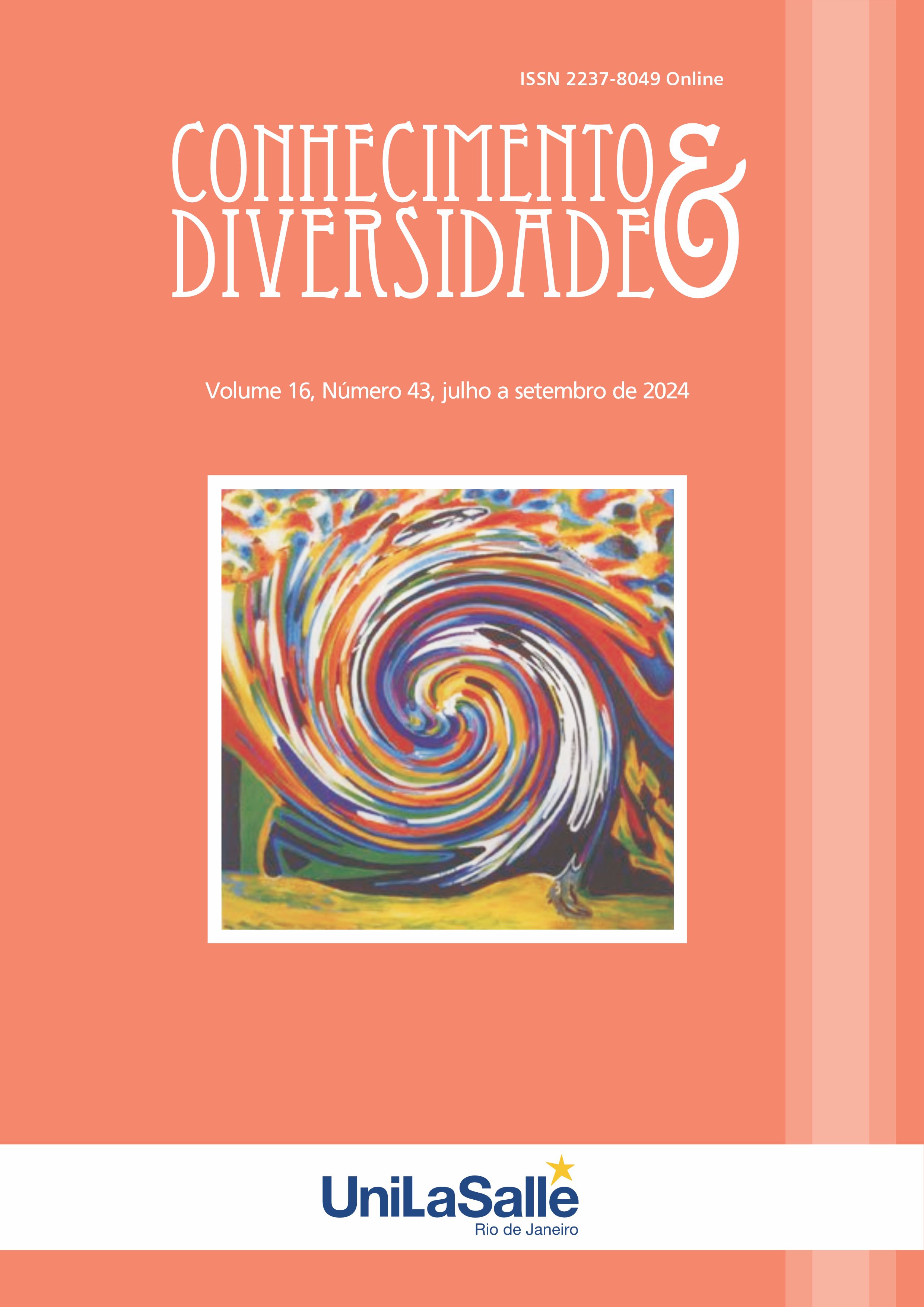VERBALIZAÇÃO DE IMAGENS DE GESTALT DE ESTADO NOS MATERIAIS DE MONUMENTOS LITERÁRIOS ALEMÃES ANTIGOS
DOI:
https://doi.org/10.18316/rcd.v16i43.11882Palavras-chave:
imagem de estado, contexto cultural, monumento literário, vocabulário, formação de identidade, visão de mundo.Resumo
O objetivo do artigo é estudar e analisar dispositivos literários, usados na literatura alemã antiga para a expressão de imagens de gestalt de estado. Métodos. Métodos de análise linguística e análise comparativa e histórico-cultural foram usados no estudo. Meios de estatística descritiva, critério de Pearson e teste U de Mann — Whitney foram usados. O uso do alfa de Cronbach garantiu a verificação da confiabilidade dos instrumentos e métodos. Resultados. A análise conduzida da comparação de três monumentos literários alemães antigos confirmou que não há diferenças significativas entre “Nibelungenlied” e “Beowulf”, o que indica a semelhança em sua estrutura e estilo. No entanto, “Nibelungenlied” difere de “Edda”, o que certifica diferenças significativas entre essas obras. “Beowulf” também demonstra diferenças significativas com “Edda”. Esses resultados também destacam semelhanças significativas entre “Nibelungenlied” e “Beowulf”, que são poemas épicos, e com “Edda”, que é uma coleção de poemas. Em particular, os aspectos filosóficos da verbalização dos estados de Gestalt foram destacados. Conclusão. O estudo descobriu que as imagens de gestalt de estado refletem não apenas imagens de personagens e cenas, mas também traduzem características e aspectos da percepção coletiva do mundo pela Sociedade Alemã Antiga. Os resultados recebidos expandem a compreensão das peculiaridades linguísticas e estilísticas da literatura alemã antiga. Perspectivas. Estudos futuros devem se concentrar na expressão de imagens de gestalt na literatura alemã moderna.
Referências
Agee, J. R. (2021). Using Historical Glottometry to subgroup the early Germanic languages. Journal of Germanic Linguistics, 33(4), 319-357. https://doi.org/10.1017/S1470542721000027
Angerer, M. L. (2021). Beyond "Germanic" and "Christian" Monoliths: Revisiting Old English and Old Saxon Biblical Epics. JEGP, Journal of English and Germanic Philology, 120(1), 73-92. https://muse.jhu.edu/pub/34/article/784082/summary
Ashurova, Z. S. (2023). Basic principles and directions of linguistic and poetic research. Journal of Education, Ethics and Value, 2(5), 58-60. https://jeev.innovascience.uz/index.php/jeev/article/view/121
Azamatova, G. S. (2023). The functioning of the noun in German language (case category). Innovative Development in Educational Activities, 2(11), 420-426. https://openidea.uz/index.php/idea/article/view/1445
Babai, P. (2023). Metahistorical reflections in the projection of modern literature. Grail of Science, 32, 240-246. https://doi.org/10.36074/grail-of-science.13.10.2023.041
Bovsunivska, Т. (2021). Modern novel in the light of frame poetics. Literary Process: Methodology, Names, Trends, 17, 16–24. https://doi.org/10.28925/2412-2475.2021.17.2
Edda, The Poetic. (2005). In: C. Larrington (Trans.). Oxford University Press. https://books.google.com.ua/books/about/The_Poetic_Edda.html?id=nBzuQZ4MCPIC&redir_esc=y
Ellis, J. M. (2022). The theory of literary criticism: A logical analysis. Univ of California Press. https://books.google.com.ua/books?hl=uk&lr=&id=o5prEAAAQBAJ&oi=fnd&pg=PR9&dq=study+of+literary+text&ots=JSuhIjRf22&sig=DelO0ECebpST62WHPlGpn6j-Kbk&redir_esc=y#v=onepage&q=study%20of%20literary%20text&f=false
Goering, N. (2023, February). Metre in Old Saxon and Old High German. In Comparative Philology Graduate Seminar. https://hcommons.org/deposits/objects/hc:51608/datastreams/CONTENT/content
Heaney, S. (2000). Beowulf. Farrar, Straus and Giroux. W. W. Norton & Company. https://www.dvusd.org/cms/lib/AZ01901092/Centricity/Domain/2897/beowulf_heaney.pdf
Jäger, A., & Walkden, G. (2021). West Germanic. Comparison and Gradation in Indo-European, 281-348. https://doi.org/10.1515/9783110641325-012
Khaydarovna, U. S. (2023). Specific Aspects of Linguistic Study of Literary Characters. Zien Journal of Social Sciences and Humanities, 16, 38-40. https://zienjournals.com/index.php/zjssh/article/view/3309
Khomenko, Т. А. (2022, September). Lexical composition of Old Germanic languages. In: The 16 th International scientific and practical conference “Modern scientific research: achievements, innovations and development prospects” (p. 219). MDPC Publishing. https://sci-conf.com.ua/wp-content/uploads/2022/09/MODERN-SCIENTIFIC-RESEARCH-ACHIEVEMENTS-INNOVATIONS...-11-13.09.22.pdf#page=219
Lewthwaite, S., & Holmes, M. M. (2018). The Pedagogy of Social Science Research Methods Textbooks. University of Southampton.
Louden, M. L. (2020). Minority Germanic languages. The Cambridge Handbook of Germanic Linguistics (pp. 807-832). https://padutch.net/wp-content/uploads/2020/04/Louden_2020_Minority_Germanic_Languages.pdf
Nishino, H. (2021). The Origin of the English Language. Tokyo Future University bulletin, 15, 213-222. https://doi.org/10.24603/tfu.15.0_213
Oxonjonovich, A. S. (2023). Peculiarities of Semantics of Phraseological Units with Zoonyms. Journal of Pedagogical Inventions and Practices, 17, 98-102. https://zienjournals.com/index.php/jpip/article/view/3454
Palii, K. V., & Lupai, O. Yu. (2021). Sources of Scandinavian mythology. Doctoral dissertation. National University «Poltava Polytechnic named after Yury Kondratyuk». http://reposit.nupp.edu.ua/handle/PoltNTU/9267
Plomp, V. R. (2020). Estimating links between latent variables using Structural Equation Modeling in R. Bachelor thesis. TU Delft. http://resolver.tudelft.nl/uuid:a3944cfc-a831-4d6c-ad0a-04605a0f1b91
Roberge, P. (2020). Contact and the history of Germanic languages. The handbook of language contact, 323-343. https://doi.org/10.1002/9781119485094.ch16
Sajjad, F., Ahmed, M., Gul, N., Ikram, S., & Sultana, N. (2023). Analysis of linguistics inventiveness for representing cultural imagination and social realities in literary translation of the crooked line by Tahira H. Naqvi. PalArch's Journal of Archaeology of Egypt/Egyptology, 20(1), 771-791. https://archives.palarch.nl/index.php/jae/article/view/11821
Shapochkina, O. V. (2020). The relevance of generative sentence structures in the state category paradigm of Old Germanic languages. Scientific Bulletin of Kherson State University. The series «German studies and intercultural communication», 1, 63-69. https://doi.org/10.32999/ksu2663-3426/2020-1-9
Shapochkina, O. V. (2022). The state category in the context of the formation conditions of ancient Germanic ethnic groups. In: The VII International Scientific and Practical Conference «Science, trends and perspectives of development». February 21 – 23, Budapest, Hungary.
Simonetti, P. (2021). The Self in/and History. RSAJournal, 32. 87-103. https://doi.org/10.13135/1592-4467/8463
Standke, M. (2023). Middle Low German thieves’ tales: Ambivalent narratives and cultural adaptations. The German Quarterly. https://doi.org/10.1111/gequ.12336
Stefanowitsch, A., Smirnova, E., & Hüning, M. (2020). Complex adpositions in three West Germanic Languages: German, Dutch, and English. In: Complex Adpositions in European Languages. A Micro-Typological Approach to Complex Nominal Relators. Berlin/Boston (pp. 65-13). Walter de Gruyter GmbH. https://books.google.com.ua/books?hl=uk&lr=&id=mfUEEAAAQBAJ&oi=fnd&pg=PA65&dq=earliest+germanic+languages+old+english&ots=_Ezc0vxxa2&sig=JuHbNZhcsjAzWWgE8HIF1_kXDq4&redir_esc=y#v=onepage&q=earliest%20germanic%20languages%20old%20english&f=false
Stifter, D. (2020). The early Celtic epigraphic evidence and early literacy in Germanic languages. Nowele, 73(1), 123-152. https://doi.org/10.1075/nowele.00037.sti
Sunnatovna, A. G. (2023). The functioning of the noun in German language (case category). British View, 8(6). https://www.britishview.co.uk/index.php/bv/article/view/255
The Nibelungenlied. (2008). In: A. T. Hatto (Trans.). Penguin Classics.
Tursunovich, R. I. (2022). Linguistic and Cultural Aspects of Literary Translation and Translation Skills. British Journal of Global Ecology and Sustainable Development, 10, 168-173. https://www.journalzone.org/index.php/bjgesd/article/view/158
Downloads
Publicado
Edição
Seção
Licença
Copyright (c) 2024 Olga Shapochkina, Olena Mashkina, Oksana Hrom, Maryna Kalashnykova, Oksana Syvyk

Este trabalho está licenciado sob uma licença Creative Commons Attribution 4.0 International License.
Conforme recomendado pelo o Public Knowledge Project, a RCD adota para seus artigos uma licença CREATIVE COMMONS: Atribuição CC BY 4.0.
Esta licença permite que outros distribuam, remixem, adaptem e construam sobre o seu trabalho, mesmo comercialmente, desde que lhe dêem crédito pela criação original.
Esta é a licença mais adequada oferecida.
Recomendado para a máxima divulgação e uso de materiais licenciados.



